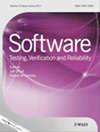经过验证和优化的Stream X - Machine测试方法,可应用于云服务认证
IF 1.2
4区 计算机科学
Q3 COMPUTER SCIENCE, SOFTWARE ENGINEERING
引用次数: 3
摘要
Stream X - Machine (SXM)测试方法提供了强大且可重复的功能正确性保证,达到规格要求。这些特性使得该方法对软件认证很有吸引力,尤其是在代理云服务领域,在这个领域,套利试图替代其他提供商提供的功能等效的服务。然而,实际的障碍包括难以提供正确的规范、将抽象路径转换为可行的具体测试以及生成的测试套件的大尺寸。我们描述了一种新的SXM验证和测试方法,它在生成具有完整接地信息的完整测试套件之前,自动检查规范的完整性和确定性。三个优化步骤可将测试套件的大小减少10倍,消除不可行和冗余的测试。该方法由一组工具支持,用于验证和验证SXM规范,生成与技术无关的测试套件,并将这些测试套件置于SOAP、REST或富客户端服务实现中。该方法最初使用七个规范、三个云平台和五种接地策略进行了验证。本文章由计算机程序翻译,如有差异,请以英文原文为准。
A verified and optimized Stream X‐Machine testing method, with application to cloud service certification
The Stream X‐Machine (SXM) testing method provides strong and repeatable guarantees of functional correctness, up to a specification. These qualities make the method attractive for software certification, especially in the domain of brokered cloud services, where arbitrage seeks to substitute functionally equivalent services from alternative providers. However, practical obstacles include the difficulty in providing a correct specification, the translation of abstract paths into feasible concrete tests and the large size of generated test suites. We describe a novel SXM verification and testing method, which automatically checks specifications for completeness and determinism, prior to generating complete test suites with full grounding information. Three optimization steps achieve up to a 10‐fold reduction in the size of the test suite, removing infeasible and redundant tests. The method is backed by a set of tools to validate and verify the SXM specification, generate technology‐agnostic test suites and ground these in SOAP, REST or rich‐client service implementations. The method was initially validated using seven specifications, three cloud platforms and five grounding strategies.
求助全文
通过发布文献求助,成功后即可免费获取论文全文。
去求助
来源期刊

Software Testing Verification & Reliability
工程技术-计算机:软件工程
CiteScore
3.70
自引率
0.00%
发文量
34
审稿时长
>12 weeks
期刊介绍:
The journal is the premier outlet for research results on the subjects of testing, verification and reliability. Readers will find useful research on issues pertaining to building better software and evaluating it.
The journal is unique in its emphasis on theoretical foundations and applications to real-world software development. The balance of theory, empirical work, and practical applications provide readers with better techniques for testing, verifying and improving the reliability of software.
The journal targets researchers, practitioners, educators and students that have a vested interest in results generated by high-quality testing, verification and reliability modeling and evaluation of software. Topics of special interest include, but are not limited to:
-New criteria for software testing and verification
-Application of existing software testing and verification techniques to new types of software, including web applications, web services, embedded software, aspect-oriented software, and software architectures
-Model based testing
-Formal verification techniques such as model-checking
-Comparison of testing and verification techniques
-Measurement of and metrics for testing, verification and reliability
-Industrial experience with cutting edge techniques
-Descriptions and evaluations of commercial and open-source software testing tools
-Reliability modeling, measurement and application
-Testing and verification of software security
-Automated test data generation
-Process issues and methods
-Non-functional testing
 求助内容:
求助内容: 应助结果提醒方式:
应助结果提醒方式:


